Nina Munteanu's Blog, page 15
December 25, 2011
I'm Dreaming of a White Christmas
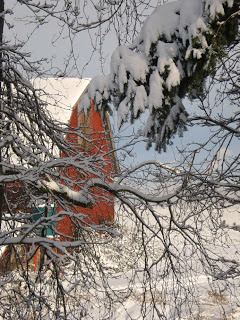 Today is Christmas! I'm back in Vancouver for a while to spend Christmas with my son and friends. It's balmy here. We drove country up to Whistler to find snow. It reminded me of a snowy Christmas I'd had several years ago in Vancouver and here's what I posted...
Today is Christmas! I'm back in Vancouver for a while to spend Christmas with my son and friends. It's balmy here. We drove country up to Whistler to find snow. It reminded me of a snowy Christmas I'd had several years ago in Vancouver and here's what I posted......A few days ago, on the Winter Solstice, a dump of snow covered the Earth in white billows. Huge flakes drifted down from heaven like confetti in a breeze.It reveals as it cloaks. Animals leave their telltale tracks behind their silent sleuthings.We are having a white Christmas—the first in over ten years here in Vancouver (on the west coast of British Columbia, Canada). And I love it.
I love how the snow wraps everything in a blanket of soft acceptance. How it creates a dazzling face on a dark Earth. How it refuses to distinguish between artificial and natural. It covers everything—decorated house, shabby old car, willowy trees, manicured lawn—beneath its white mantle. I love how it quiets the Earth. Have you ever gone for a walk in the fresh snow? Boots crunching… snow glistening in the moonlight…Snow is magic.
It beckons you to stick out your tongue and taste the clouds. Snow is like an unruly child. Snow is the trickster. It stirs things up. Makes a mess. It is the herald of change, invigorating, fresh and wondrous. Cars skid in it and squeal with objection. Grumpy drivers honk their horns, impatient to get home; while others sigh in their angry wake. Boys (of all ages) venture outside, mischief glinting in their eyes, and throw snowballs. Others, fearful of the chaos and confusion that snow brings, hide indoors out of the cold.Snow is playful.
It brings out the best and the worst in people. The Christmas season—whether you are a Christian celebrating the birth of Jesus or of another faith celebrating the season of Joy and Giving—provides each of us with the opportunity to be exactly who we are and who we are meant to be. It is a time to be genuine. A time to be sincere. A time to be REAL. A time to make the best of our lot and be thankful: whether we are celebrating a turkey feast with a family we don't get along with, alone in a new town, or working the night shift in a busy firm. It is a time to be thankful for the gifts we have been blessed with, even the hardships. Especially the hardships. For they are ours to carry. Ours to make into something wonderful.Snow is Christmas.
MERRY CHISTMAS everyone!
Published on December 25, 2011 00:38
December 5, 2011
New Trailer for "Outer Diverse"
Check it out! It's BOSS!
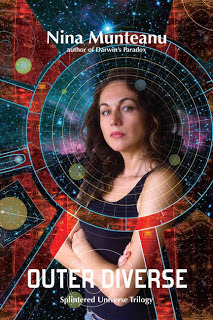
And go nominate Costi Gurgu for the Aurora Prix Award for Best cover art. He deserves it! You can nominate him on the Aurora site starting January 1, 2012, when the nominations open. Looks like you have to be a member to nominate. Used to be ANY Canadian could nominate works for the Aurora. I might have my information wrong, so go check out the site on January 1st to nominate Costi for his splendid artwork to produce the cover of Outer Diverse.

And go nominate Costi Gurgu for the Aurora Prix Award for Best cover art. He deserves it! You can nominate him on the Aurora site starting January 1, 2012, when the nominations open. Looks like you have to be a member to nominate. Used to be ANY Canadian could nominate works for the Aurora. I might have my information wrong, so go check out the site on January 1st to nominate Costi for his splendid artwork to produce the cover of Outer Diverse.
Published on December 05, 2011 19:22
November 16, 2011
How to Hook Your Reader and Deliver
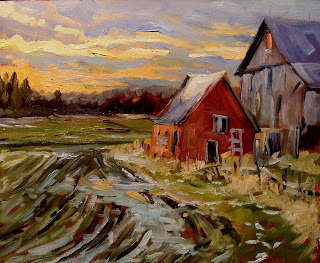 A great story opening arouses, delays and rewards. Constructing a compelling beginning—often called a hook—is a common challenge for even established writers, and one of the most important parts of a story.
A great story opening arouses, delays and rewards. Constructing a compelling beginning—often called a hook—is a common challenge for even established writers, and one of the most important parts of a story.The opening of a story should sweep the reader into the story like a tidal wave. It doesn't need to be wild action. It just needs to compel the reader to want to know more. This is accomplished by engaging the reader with "intrigue". In his article "Three Ways to Keep Your Readers Hooked" in the April 2001 issue of Writer's Digest, Joe Cardillo suggested that the three elements of hooking a reader resemble the steps he uses to train his Samoyed puppy: 1) arouse interest; 2) delay, then 3) reward.
The writer arouses interest in the reader by providing enough detail to get the reader to ask questions. Now they want something. You tease them with the delay; that keeps them reading and turning the pages. It also gives them the chance to try to come up with the answers themselves. The reward comes in stages. Don't answer all their questions at once. That's what the book—the story—is for. The reward, parceled out in stages, lets the reader know that you can deliver and will ultimately provide them with a fulfilling story at the end. The beginning of your book sets up a covenant between you and the reader, a covenant for a journey you will take together toward resolution.
There is no beginning without an end. In her book The Sell Your Novel Tool Kit (Revised Edition, Perigee Trade, 2002) Elizabeth Lyon suggested that the beginning of a novel should "reflect the entire book. There should be a tie-in [between] the beginning and the end". This is sometimes called "framing" a story, where the principal thematic problem is given in the beginning and then resolved in the end. In his book, A Story is a Promise (Blue Heron Publishing, 2000) Bill Johnson describes it as a promise to the reader.
"Dramatic story-issues revolve around issues of human need," says Johnson. "The need to be loved. To have control of one's fate. To feel a sense of purpose. To be able to overcome obstacles. To be able to grow and heal from life's wounds. To understand and make sense of the events of life." He warns that "if you can't name the issue at the heart of your story [the theme], it risks being unclear to your audience." And this needs to be identified, at least intuitively for the reader, at the beginning of the story. You do this through intrigue in the beginning and pointing out through scene what is at stake or at issue in your story.
Additional things to consider in openings include:
• Avoid starting your story at "the beginning": instead, start mid-way, when something is already happening—preferably to someone important in your story and at the pivotal point when you provide the "story promise" pertinent to the theme.
• Quell the urge to put in a lot of information about setting, character and situation: get things in motion first, then reveal here and there. Let the details unfold with the story like a flowing piece of artwork.
• Trust your reader: novice writers have not yet gained the confidence to trust that they won't lose the reader in the beginning if they don't tell them everything right away. The key is to choose just enough to whet their appetite for more. And, yes, it is critical what you choose. What you choose should relate to your story's theme and its story promise: the problem.
A great opening is a seductive tease, deliciously delivered; it promises an exotic ride that only you can fulfill.
Recommended Reading:
Cardillo, Joe. 2001. "Three Ways to Keep Your Readers Hooked". Writer's Digest, April, 2001, volume 81, no. 4.
Johnson, Bill. 2000. A Story Is a Promise. Blue Heron Publishing. Portland, Oregon. 187pp.
Lyon, Elizabeth. 2002. The Sell Your Novel Took Kit. Revised Edition. Perigee Trade. 320pp.
Munteanu, Nina. 2009. The Fiction Writer: Get Published, Write Now! (Chapter B) Starfire World Syndicate, Louisville, KY. 264pp.
Published on November 16, 2011 12:03
November 9, 2011
A Hero's Journey: Part 2, Heroes and Other Archetypes
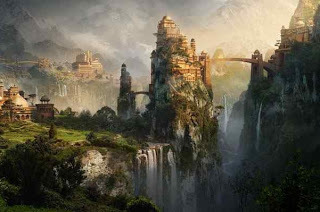 The world of fairy tales and myth is peopled with recurring character types and relationships. Heroes on a quest, heralds and wise old men or women who provide them with "gifts" or motive, shady fellow-travelers—threshold guardians—who "block" the quest, tricksters who confuse things and evil villains who simply want to destroy our hero and her quest.
The world of fairy tales and myth is peopled with recurring character types and relationships. Heroes on a quest, heralds and wise old men or women who provide them with "gifts" or motive, shady fellow-travelers—threshold guardians—who "block" the quest, tricksters who confuse things and evil villains who simply want to destroy our hero and her quest. Jung adopted the term archetypes, which means ancient patterns of personality shared by humanity, to describe these as a collective unconscious. An archetype models a personality or behavior; a mother-figure is an archetype. This is what makes archetypes, or symbols, so important to the storyteller. Archetypes are found in nearly all forms of literature, with their motifs mostly rooted in folklore.
Assigning an archetype to a character lets the writer clarify that character's role in the story. Archetypes are an important tool in the universal language of storytelling, just as myth serves the overall purpose of supplying "the symbols that carry the human spirit forward." (Joseph Campbell). Joseph Campbell went so far as to describe the archetype as something that is expressed biologically and is wired into every human being.
Christopher Vogler, author of The Writer's Journey, lists the seven most useful archetypes for the writer.
The Hero
The hero sacrifices his own needs on behalf of others. He provides a character for us to identify with and is usually the principal POV character in a story, with qualities most readers can (or want to) identify with. The hero "transforms" through her journey as she encounters other archetypes on her journey, whether it is a physical journey or a psychological journey toward "home" (salvation or redemption) through sacrifice. The true mark of the hero, says Vogler, is in the act of sacrifice: "the hero's willingness to give up something of value, perhaps even her own life, on behalf of an ideal or a group," and ultimately for the greater good.
Heroes may be willing or unwilling. Anti-heroes are notably flawed characters that must grow significantly to achieve the status of true hero. Often the anti-hero starts off more like a villain, like Tom Cruise's character in Rainman. The wounded anti-hero may be a "heroic knight in tarnished armor, a loner who has rejected society or been rejected by it," says Vogler: Aragorn in Lord of the Rings. The catalyst hero shows less of a character arc, but precipitates significant change or transformation in other protagonists. A good example is David Adams, in Ben Bova's Colony.
The Mentor
The mentor often possesses divine wisdom and has faith in the hero. He often gives the hero a "gift", which is usually something important for the quest; either a weapon to destroy a "monster" or a "talisman" to enlighten the hero. A good example is in Star Wars, when Luke's mentor, Obi Wan, provides him with his father's lightsaber (Luke's magic talisman).
The Herald
Heralds announce the coming of significant change, whether the hero likes it or not (and usually they don't). They deliver the call to adventure. The herald is a catalyst that enters the story and makes it impossible for the hero to remain in status quo. Existing in the form of a person, an event, or just information, they shift the hero's balance and change her world.
In Star Wars, Ben Kenobi issues the call when he invites Luke to join him on his mission to Alderaan. The herald also provides the hero with motivation. In Romancing the Stone, the herald for Joan Wilder comes to her as a treasure map in the mail, and a distressed phone call from her sister.
The Threshold Guardian
This archetype guards the threshold of "Separation from the Ordinary World" on the hero's quest to achieve his destiny. Threshold guardians spice up the story by providing obstacles the hero must overcome. Threshold guardians are usually not the main antagonist. In the Harry Potter series, this role is fulfilled by Malfoy, Snape or Filch, even. They help round-out the hero's journey and develop his character arc. The threshold guardian can be a "friend" who doesn't believe in the hero or her quest. Ultimately, this is the role of the threshold guardian: to test the hero's resolve in her quest.
The Shape shifter
The shape shifter adds dramatic tension to the story and provides the hero with a puzzle to solve. They can seem one thing and in fact be another. They bring doubt and suspense to the story and test the hero's abilities to discern her path. Yoda in Star Wars is a bit of a shape shifter, initially masking his ancient wisdom with a foolish childlike appearance when Luke first encounters him.
The Shadow
The monster under the bed, repressed feelings, deep trauma, a festering guilt: these all possess the dark energy of the shadow. This is the dark force of the unexpressed, unrealized, rejected, feared aspects of the hero and represented by the main antagonist or villain.
Voldermort in the Harry Potter series; Darth Vader in Star Wars. These are shadows and worthy opponents for the hero, bringing out the best in her and usually demanding the ultimate in self-sacrifice (the hero's destiny).The shadow force, if internalized by the hero, may serve as a threshold guardian, to overcome; ultimately challenging the hero to overcome her greatest weakness and prevail.
The Trickster
Practically every Shakespearian play contains a jester or fool, who not only serves as comic relief but as commentator. This is because tricksters are usually witty and clever, even when ridiculous. The comedy of most successful comedians touches upon the pulse of a culture by offering commentary that is truism (often in the form of entertaining sarcasm).
Recommended Reading:
Cameron, Julia. 1992. The Artist's Way: a Spiritual Path to Higher Creativity. Penguin Putnam. 222pp.
Campbell, Joseph. 1970. The Hero with a Thousand Faces. World Publishing Co. New York.
Henderson, Mary. 1997. Star Wars: The Magic of Myth. Bantam Spectra. New York. 214pp.
Vogler, Christopher. 1998. The Writer's Journey: Mythic Structure for Writers. 2nd Edition. Michael Wiese Productions, Studio City, California. 326pp.
Published on November 09, 2011 21:08
November 2, 2011
The Hero's Journey: Part One, the Hero & the Journey
[image error]
All stories consist of … common structural elements found universally in myths, fairy tales, dreams, and movies. They are known collectively as The Hero's Journey — Christopher Vogler, "The Writer's Journey: Mythic Structure for Writers"
"The Hero's Journey" myth follows the three-act structure of the ancient Greek play, handed down to us thousands of years ago. Drawn from the depth psychology of Swiss psychologist Carl Jung and the scholar and mythologist Joseph Campbell, author of The Hero with a Thousand Faces, it duplicates the steps of the "Rite of Passage" and is a process of self-discovery and self-integration.
The Power of Myth & Archetype
Campbell recognized that myths weren't just abstract theories or quaint ancient beliefs but practical models for understanding how to live. Ultimately, the Hero's Journey is the soul's search for "home". It is a journey of transformation we all take, in some form. This is why the Hero's Journey model for writing is so relevant and why it appeals to all readers.
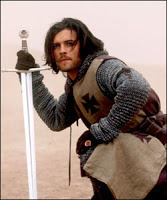 Jung proposed that symbols appear to us when there is a need to express what thought cannot think or what is only divined or felt. Jung discovered reoccurring symbols among differing peoples and cultures, unaffected by time and space. He described these shared symbols as archetypes: irrepressible, unconscious, pre-existing forms of the psyche. Joseph Campbell suggested that these mythic images lay at the depth of the unconscious where humans are no longer distinct individuals, where our minds widen and merge into the mind of humankind. Where we are all the same.
Jung proposed that symbols appear to us when there is a need to express what thought cannot think or what is only divined or felt. Jung discovered reoccurring symbols among differing peoples and cultures, unaffected by time and space. He described these shared symbols as archetypes: irrepressible, unconscious, pre-existing forms of the psyche. Joseph Campbell suggested that these mythic images lay at the depth of the unconscious where humans are no longer distinct individuals, where our minds widen and merge into the mind of humankind. Where we are all the same.
[image error] The Hero's Journey in Storytelling
Compelling stories resonate with the universal truths of metaphor within the consciousness of humanity. According to Joseph Campbell this involves an open mind and a certain amount of humility; and giving oneself to the story...not unlike the hero who gives her life to something larger than herself: "Anyone writing a creative work knows that you yield yourself, and the book talks to you and builds itself....you become the carrier of something that is given to you from … the Muses or God. This is no fancy, it is a fact. Since the inspiration comes from the unconscious, and since the unconscious minds of the people of any single small society have much in common, what the shaman or seer [or artist] brings forth is something that is waiting to be brought forth in everyone." I call this tapping into the universal truth where metaphor lives. A story comes alive when these two resonate.
Vogler suggested that using the principles of myth, helps "create a masterful story that is dramatic, entertaining, and psychologically true."
The Hero and the Journey
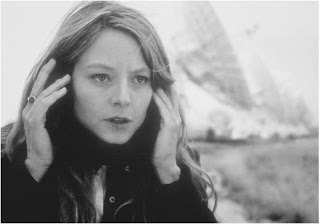 Heroes are agents of change on a quest. The hero is the ultimate altruist, sacrificing her life for the greater good. She is warrior and lover who slays the dragon of the status quo, so to speak. She enacts the ultimate in sacrifice in her quest to change the world (and/or herself). The hero's task has always been to bring new life to an ailing culture, says Carol S. Pearson, author of The Hero Within. Julia Cameron reiterates this in her book, The Artist's Way, when she describes the concept of art as a healing journey (not just for the individual but for a culture). This is because the writer/artist changes society by changing themselves.
Heroes are agents of change on a quest. The hero is the ultimate altruist, sacrificing her life for the greater good. She is warrior and lover who slays the dragon of the status quo, so to speak. She enacts the ultimate in sacrifice in her quest to change the world (and/or herself). The hero's task has always been to bring new life to an ailing culture, says Carol S. Pearson, author of The Hero Within. Julia Cameron reiterates this in her book, The Artist's Way, when she describes the concept of art as a healing journey (not just for the individual but for a culture). This is because the writer/artist changes society by changing themselves.
Campbell describes a 12-step journey of the hero within 3-acts and influenced by five major archetypes (herald, mentor, threshold guardian, trickster, shadow and shapeshifter). Our hero starts her journey in Act 1 — in the Ordinary World — and will eventually separate from the Ordinary World in Act 2— entering the Special World, where she will transform through her many challenges. In Act 3, she re-enters the Ordinary World, changed, with her gift to the world. I'll go into more detail about how you integrate other archetypes and the steps of the journey in "storytelling" in Parts 2 and 3 of this series.
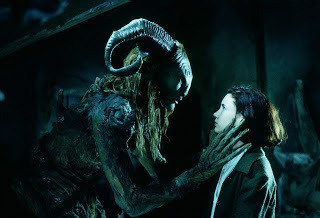 For now, let's concentrate on our hero and what her journey means to her. She begins her quest with one giant step. How does she do it? How does she muster up the courage and resolution to proceed (often against all odds) on a journey that promises only challenge and hardship. She does so because our hero, whether she realizes it or not, has faith in her quest (even if she may not have faith in herself).
For now, let's concentrate on our hero and what her journey means to her. She begins her quest with one giant step. How does she do it? How does she muster up the courage and resolution to proceed (often against all odds) on a journey that promises only challenge and hardship. She does so because our hero, whether she realizes it or not, has faith in her quest (even if she may not have faith in herself).
In some versions of the Holy Grail quest, relates Pearson, the hero reaches a huge chasm with no apparent way to get across to the Grail castle. The space is too great for him to jump across. Then he remembers the Grail teaching that instructs him to step out in faith. As he puts one foot out into the abyss, a bridge magically appears and he is saved. Anyone who has left a job, school, one's home town, or a relationship has stepped out into that abyss, separating them from the familiar world they've known.
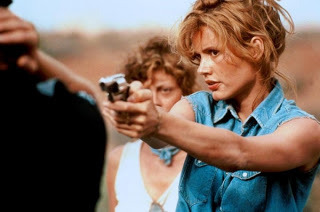 Just as "the knights of King Arthur's Round Table set off to seek the Holy Grail," says Mary Henderson, author of StarWars: The Magic of Myth, "the great figures of every major religion have each gone on a 'vision quest', from Moses' journey to the mountain, to Jesus' time in the desert, Muhammad's mediations in the mountain cave, and Buddha's search for enlightenment that ended under the Bodhi tree." The journey, and the abyss, is often not a physical adventure, adds Henderson, but a spiritual one, "as the hero moves from ignorance and innocence to experience and enlightenment."
Just as "the knights of King Arthur's Round Table set off to seek the Holy Grail," says Mary Henderson, author of StarWars: The Magic of Myth, "the great figures of every major religion have each gone on a 'vision quest', from Moses' journey to the mountain, to Jesus' time in the desert, Muhammad's mediations in the mountain cave, and Buddha's search for enlightenment that ended under the Bodhi tree." The journey, and the abyss, is often not a physical adventure, adds Henderson, but a spiritual one, "as the hero moves from ignorance and innocence to experience and enlightenment."
Here are the 12 steps of the Hero's Journey:
ACT ONE: Separation
• Ordinary World
• Call to Adventure
• Refusal of the Call
• Meeting with the Mentor
• Crossing the Threshold
ACT TWO: Initiation & Transformation
• Tests, Allies, Enemies
• Approach to the Innermost Cave
• Ordeal (Abyss)
• Reward/Seizing the Sword (Transformation and Revelation)
ACT THREE: the Return
• The Road Block
• Resurrection / Atonement
• Return with the Elixor
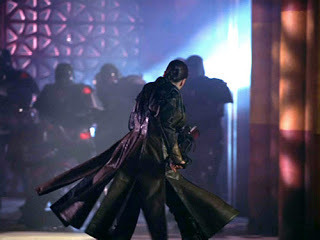 I'll talk about these in more detail and show you some examples in Part Three of my Hero's Journey series. Stay tuned for "The Hero's Journey—Part Two, Archetypes" next week.
I'll talk about these in more detail and show you some examples in Part Three of my Hero's Journey series. Stay tuned for "The Hero's Journey—Part Two, Archetypes" next week.
I teach an online course in "The Hero's Journey" through my educational website, http://www.ninamunteanu.com/.
Recommended Reading:
• Cameron, Julia. 1992. The Artist's Way: a Spiritual Path to Higher Creativity. Penguin Putnam. 222pp.
• Campbell, Joseph. 1970. The Hero with a Thousand Faces. World Publishing Co. New York.
• Campbell, Joseph. 1988. The Power of Myth.
• Henderson, Mary. 1997. Star Wars: The Magic of Myth. Bantam Spectra. New York. 214pp.
• Munteanu, Nina. 2009. The Fiction Writer: Get Published, Write Now! Starfire World Syndicate, Louisville, KY. 266pp.
• Pearson, Carol S. 1998. The Hero Within: Six Archetypes We Live By. Harper. San Francisco. 3rd Edition.
• Vogler, Christopher. 1998. The Writer's Journey: Mythic Structure for Writers. 2nd Edition. Michael Wiese Productions, Studio City, California. 326pp.
"The Hero's Journey" myth follows the three-act structure of the ancient Greek play, handed down to us thousands of years ago. Drawn from the depth psychology of Swiss psychologist Carl Jung and the scholar and mythologist Joseph Campbell, author of The Hero with a Thousand Faces, it duplicates the steps of the "Rite of Passage" and is a process of self-discovery and self-integration.
The Power of Myth & Archetype
Campbell recognized that myths weren't just abstract theories or quaint ancient beliefs but practical models for understanding how to live. Ultimately, the Hero's Journey is the soul's search for "home". It is a journey of transformation we all take, in some form. This is why the Hero's Journey model for writing is so relevant and why it appeals to all readers.
 Jung proposed that symbols appear to us when there is a need to express what thought cannot think or what is only divined or felt. Jung discovered reoccurring symbols among differing peoples and cultures, unaffected by time and space. He described these shared symbols as archetypes: irrepressible, unconscious, pre-existing forms of the psyche. Joseph Campbell suggested that these mythic images lay at the depth of the unconscious where humans are no longer distinct individuals, where our minds widen and merge into the mind of humankind. Where we are all the same.
Jung proposed that symbols appear to us when there is a need to express what thought cannot think or what is only divined or felt. Jung discovered reoccurring symbols among differing peoples and cultures, unaffected by time and space. He described these shared symbols as archetypes: irrepressible, unconscious, pre-existing forms of the psyche. Joseph Campbell suggested that these mythic images lay at the depth of the unconscious where humans are no longer distinct individuals, where our minds widen and merge into the mind of humankind. Where we are all the same.[image error] The Hero's Journey in Storytelling
Compelling stories resonate with the universal truths of metaphor within the consciousness of humanity. According to Joseph Campbell this involves an open mind and a certain amount of humility; and giving oneself to the story...not unlike the hero who gives her life to something larger than herself: "Anyone writing a creative work knows that you yield yourself, and the book talks to you and builds itself....you become the carrier of something that is given to you from … the Muses or God. This is no fancy, it is a fact. Since the inspiration comes from the unconscious, and since the unconscious minds of the people of any single small society have much in common, what the shaman or seer [or artist] brings forth is something that is waiting to be brought forth in everyone." I call this tapping into the universal truth where metaphor lives. A story comes alive when these two resonate.
Vogler suggested that using the principles of myth, helps "create a masterful story that is dramatic, entertaining, and psychologically true."
The Hero and the Journey
 Heroes are agents of change on a quest. The hero is the ultimate altruist, sacrificing her life for the greater good. She is warrior and lover who slays the dragon of the status quo, so to speak. She enacts the ultimate in sacrifice in her quest to change the world (and/or herself). The hero's task has always been to bring new life to an ailing culture, says Carol S. Pearson, author of The Hero Within. Julia Cameron reiterates this in her book, The Artist's Way, when she describes the concept of art as a healing journey (not just for the individual but for a culture). This is because the writer/artist changes society by changing themselves.
Heroes are agents of change on a quest. The hero is the ultimate altruist, sacrificing her life for the greater good. She is warrior and lover who slays the dragon of the status quo, so to speak. She enacts the ultimate in sacrifice in her quest to change the world (and/or herself). The hero's task has always been to bring new life to an ailing culture, says Carol S. Pearson, author of The Hero Within. Julia Cameron reiterates this in her book, The Artist's Way, when she describes the concept of art as a healing journey (not just for the individual but for a culture). This is because the writer/artist changes society by changing themselves. Campbell describes a 12-step journey of the hero within 3-acts and influenced by five major archetypes (herald, mentor, threshold guardian, trickster, shadow and shapeshifter). Our hero starts her journey in Act 1 — in the Ordinary World — and will eventually separate from the Ordinary World in Act 2— entering the Special World, where she will transform through her many challenges. In Act 3, she re-enters the Ordinary World, changed, with her gift to the world. I'll go into more detail about how you integrate other archetypes and the steps of the journey in "storytelling" in Parts 2 and 3 of this series.
 For now, let's concentrate on our hero and what her journey means to her. She begins her quest with one giant step. How does she do it? How does she muster up the courage and resolution to proceed (often against all odds) on a journey that promises only challenge and hardship. She does so because our hero, whether she realizes it or not, has faith in her quest (even if she may not have faith in herself).
For now, let's concentrate on our hero and what her journey means to her. She begins her quest with one giant step. How does she do it? How does she muster up the courage and resolution to proceed (often against all odds) on a journey that promises only challenge and hardship. She does so because our hero, whether she realizes it or not, has faith in her quest (even if she may not have faith in herself).In some versions of the Holy Grail quest, relates Pearson, the hero reaches a huge chasm with no apparent way to get across to the Grail castle. The space is too great for him to jump across. Then he remembers the Grail teaching that instructs him to step out in faith. As he puts one foot out into the abyss, a bridge magically appears and he is saved. Anyone who has left a job, school, one's home town, or a relationship has stepped out into that abyss, separating them from the familiar world they've known.
 Just as "the knights of King Arthur's Round Table set off to seek the Holy Grail," says Mary Henderson, author of StarWars: The Magic of Myth, "the great figures of every major religion have each gone on a 'vision quest', from Moses' journey to the mountain, to Jesus' time in the desert, Muhammad's mediations in the mountain cave, and Buddha's search for enlightenment that ended under the Bodhi tree." The journey, and the abyss, is often not a physical adventure, adds Henderson, but a spiritual one, "as the hero moves from ignorance and innocence to experience and enlightenment."
Just as "the knights of King Arthur's Round Table set off to seek the Holy Grail," says Mary Henderson, author of StarWars: The Magic of Myth, "the great figures of every major religion have each gone on a 'vision quest', from Moses' journey to the mountain, to Jesus' time in the desert, Muhammad's mediations in the mountain cave, and Buddha's search for enlightenment that ended under the Bodhi tree." The journey, and the abyss, is often not a physical adventure, adds Henderson, but a spiritual one, "as the hero moves from ignorance and innocence to experience and enlightenment."Here are the 12 steps of the Hero's Journey:
ACT ONE: Separation
• Ordinary World
• Call to Adventure
• Refusal of the Call
• Meeting with the Mentor
• Crossing the Threshold
ACT TWO: Initiation & Transformation
• Tests, Allies, Enemies
• Approach to the Innermost Cave
• Ordeal (Abyss)
• Reward/Seizing the Sword (Transformation and Revelation)
ACT THREE: the Return
• The Road Block
• Resurrection / Atonement
• Return with the Elixor
 I'll talk about these in more detail and show you some examples in Part Three of my Hero's Journey series. Stay tuned for "The Hero's Journey—Part Two, Archetypes" next week.
I'll talk about these in more detail and show you some examples in Part Three of my Hero's Journey series. Stay tuned for "The Hero's Journey—Part Two, Archetypes" next week.I teach an online course in "The Hero's Journey" through my educational website, http://www.ninamunteanu.com/.
Recommended Reading:
• Cameron, Julia. 1992. The Artist's Way: a Spiritual Path to Higher Creativity. Penguin Putnam. 222pp.
• Campbell, Joseph. 1970. The Hero with a Thousand Faces. World Publishing Co. New York.
• Campbell, Joseph. 1988. The Power of Myth.
• Henderson, Mary. 1997. Star Wars: The Magic of Myth. Bantam Spectra. New York. 214pp.
• Munteanu, Nina. 2009. The Fiction Writer: Get Published, Write Now! Starfire World Syndicate, Louisville, KY. 266pp.
• Pearson, Carol S. 1998. The Hero Within: Six Archetypes We Live By. Harper. San Francisco. 3rd Edition.
• Vogler, Christopher. 1998. The Writer's Journey: Mythic Structure for Writers. 2nd Edition. Michael Wiese Productions, Studio City, California. 326pp.
Published on November 02, 2011 06:03
October 24, 2011
What a Con*Cept! Nina Launches Outer Diverse in Montreal
[image error]
Nina launches "Outer Diverse"
Last weekend I met old friends Toulouse and Vanessa in Montreal to attend Con*Cept 2011 at the Espresso Hotel and to launch my new book Outer Diverse , the first book of The Splintered Universe Trilogy . Con*Cept is Montreal's Annual Science Fiction and Fantasy Convention on October 14-16, 2011.
I met Vanessa and Toulouse in the hotel lobby. Toulouse—cool cat that he is—pointed out the espresso machine behind the front desk and winked. I ordered a double shot of the strong brew and watched Toulouse down his single shot (a lot for a small stuffed cat) in three major inhales. If he was a SIM he would have shivered with elation and uttered the SIM word for "Arriva!" What an auspicious start to Montreal's annual science-fiction and fantasy convention!
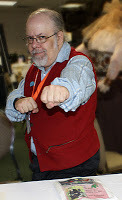
Ira Nayman
The 3-day con was smallish in numbers but made up for it with a huge heart, lots of character (or is that characters?), and a good selection of panels and workshops, including a workshop on World Building by yours truly.
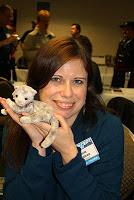
Marie Bilodeau
I shared an interesting panel on Politics in SF (From Avatar to Zardoz) with comedic author Ira Nayman, writer and critic Kathryn Cramer, and Mark Shainblum, SF/F and comic book writer. I didn't see Toulouse in the audience; I think he lured Vanessa downstairs to the lobby for more espresso—the lush! I followed with a panel called "Characters or Real People" with the effervescent Violette Malan, author of The Shadowlands, and Nanowrimo wiz Rebecca Blain. We were the real characters. Both Vanessa and Toulouse managed to show up for the launch of my space adventure-thriller Outer Diverse, espresso cups in hand.

Vanessa in the Dealer's Room
Vanessa is a master jeweler; she created and launched a jewelry line specifically for Rhea Hawke, the bold space detective of the series. It was astonishing! The dealer's room was abuzz with interest for the clean bold lines of the Rhea Hawke Collection. You can find it featured in her online shop on Etsy.
[image error]
Mark Shainblum with Toulouse
My World Building workshop was well-attended by a diverse crowd that ranged from a young teenage girl writing a dystopian science fiction novel to a retired physicist writing an urban fantasy. I got out my tablet and magic pen and embarked on my interactive power point presentation. Everyone seemed to understand my ninonian scrawl and asked great questions. We covered a wide range of topics from first contact and achieving realism to integrating world with theme and premise.
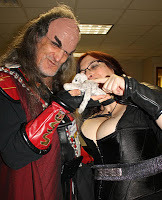
Toulouse finds some friends
Eric Flint, author of the 1632 Alternate History Series, was the Guest of Honor. Eric comes by his alternate history works naturally: he graduated Phi Beta Kappa form the University of California in LA, majoring in history. Despite his academic credentials, Eric took on a varied working life including longshoreman, truck driver, steel worker, meatpacker, glassblower and machinist. I'm sure all those positions provided fertile ground for storytelling.
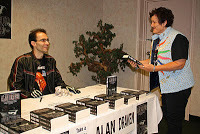
Alan Draven and Vanessa talk books
Interested in buying one of my books, Eric asked me which was my favorite. His question took me unawares and I had to think. Books are like children. At one time or another each is your favorite. Realizing that he was looking for some guidance, I pointed out my environmental thriller Darwin's Paradox. He ended up buying its prequel, Angel of Chaos. Funny that…
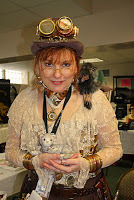 The con offered the regular meal of obligatory Doctor Who Panel, Klingons and Star Trek crew on shore leave, masquerade and dance, film and filking and—of course—never-ending room parties. Because this was Montreal—and Vanessa's first time there—we dove into the city each night for a taste of Montreal culture and fine dining. Toulouse directed us first to an Italian restaurant on Cresent Street. The ambience was in perfect keeping with the con: the spatious restaurant offered a steampunkish-retro-industrial environs. We enjoyed an authentic Italian meal under high ceilings, surrounded by brick walls and one entire wall dedicated—like a tall bookshelf—to storing wine. Another night we strolled into Old Montreal and found several cafés to dine and drink (see Toulouse's post).
The con offered the regular meal of obligatory Doctor Who Panel, Klingons and Star Trek crew on shore leave, masquerade and dance, film and filking and—of course—never-ending room parties. Because this was Montreal—and Vanessa's first time there—we dove into the city each night for a taste of Montreal culture and fine dining. Toulouse directed us first to an Italian restaurant on Cresent Street. The ambience was in perfect keeping with the con: the spatious restaurant offered a steampunkish-retro-industrial environs. We enjoyed an authentic Italian meal under high ceilings, surrounded by brick walls and one entire wall dedicated—like a tall bookshelf—to storing wine. Another night we strolled into Old Montreal and found several cafés to dine and drink (see Toulouse's post).
[image error]
Karen Dales and Toulouse
As with all good cons, Con*Cept provided a venue to meet old friends and make new ones. The only thing missing was a decent bar (but then again there were those room parties and all of Montreal!) I visited with the vivacious and award-winning author and wizard storyteller Marie Bilodeau.
Marie was there with her newest space fantasy adventure Destiny's Blood, short-listed for the Aurora. Go, Marie! I also visited with Claire Eamers, who just published her story in Tesseracts Fifteen.
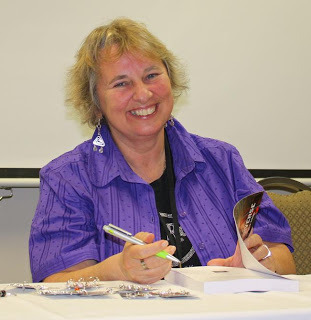
Nina signing Outer Diverse
Some new faces for me included the con-hopping Karen Dales, award-winning author of the paranormal series The Chosen Chronicles (see you at AdAstra, Karen!) I had the fortune of sharing a panel with the witty and elegant Violette Malan, author of The Mirror Prince—she's such a snappy dresser! Then there was Ira Nayman (the witty superhero with vim, vigor and a few other things that I'm still trying to figure out…). And Mark Shainblum, the debonair and charming SF&F writer and comic book writer, who gave Toulouse some good advice about wearing black. I also met Alan Draven, fresh from comic con with his newest book, Fractured Time.
The dealer's room was a cornucopia of fine jewelry, steampunk accessories, books, games and strange looking people. I felt at home.
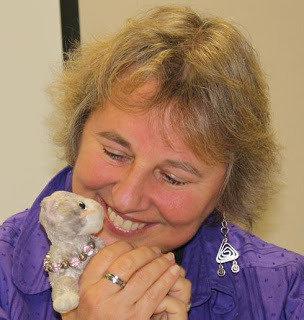 Merci to Cathy Palmer-Lister, Marc Nadeau, Howard Picaizen, Rene Walling and all the other convention volunteers who made Con*Cept a friendly, warm and fun event.
Merci to Cathy Palmer-Lister, Marc Nadeau, Howard Picaizen, Rene Walling and all the other convention volunteers who made Con*Cept a friendly, warm and fun event.
p.s. Just looking at the pictures ... for a cat who spent a lot of time down in the lobby drinking free espressos, Toulouse sure got around! Way to go, Toulouse!
[image error]
Nina launches "Outer Diverse"
Last weekend I met old friends Toulouse and Vanessa in Montreal to attend Con*Cept 2011 at the Espresso Hotel and to launch my new book Outer Diverse , the first book of The Splintered Universe Trilogy . Con*Cept is Montreal's Annual Science Fiction and Fantasy Convention on October 14-16, 2011.
I met Vanessa and Toulouse in the hotel lobby. Toulouse—cool cat that he is—pointed out the espresso machine behind the front desk and winked. I ordered a double shot of the strong brew and watched Toulouse down his single shot (a lot for a small stuffed cat) in three major inhales. If he was a SIM he would have shivered with elation and uttered the SIM word for "Arriva!" What an auspicious start to Montreal's annual science-fiction and fantasy convention!

Ira Nayman
The 3-day con was smallish in numbers but made up for it with a huge heart, lots of character (or is that characters?), and a good selection of panels and workshops, including a workshop on World Building by yours truly.

Marie Bilodeau
I shared an interesting panel on Politics in SF (From Avatar to Zardoz) with comedic author Ira Nayman, writer and critic Kathryn Cramer, and Mark Shainblum, SF/F and comic book writer. I didn't see Toulouse in the audience; I think he lured Vanessa downstairs to the lobby for more espresso—the lush! I followed with a panel called "Characters or Real People" with the effervescent Violette Malan, author of The Shadowlands, and Nanowrimo wiz Rebecca Blain. We were the real characters. Both Vanessa and Toulouse managed to show up for the launch of my space adventure-thriller Outer Diverse, espresso cups in hand.

Vanessa in the Dealer's Room
Vanessa is a master jeweler; she created and launched a jewelry line specifically for Rhea Hawke, the bold space detective of the series. It was astonishing! The dealer's room was abuzz with interest for the clean bold lines of the Rhea Hawke Collection. You can find it featured in her online shop on Etsy.
[image error]
Mark Shainblum with Toulouse
My World Building workshop was well-attended by a diverse crowd that ranged from a young teenage girl writing a dystopian science fiction novel to a retired physicist writing an urban fantasy. I got out my tablet and magic pen and embarked on my interactive power point presentation. Everyone seemed to understand my ninonian scrawl and asked great questions. We covered a wide range of topics from first contact and achieving realism to integrating world with theme and premise.

Toulouse finds some friends
Eric Flint, author of the 1632 Alternate History Series, was the Guest of Honor. Eric comes by his alternate history works naturally: he graduated Phi Beta Kappa form the University of California in LA, majoring in history. Despite his academic credentials, Eric took on a varied working life including longshoreman, truck driver, steel worker, meatpacker, glassblower and machinist. I'm sure all those positions provided fertile ground for storytelling.

Alan Draven and Vanessa talk books
Interested in buying one of my books, Eric asked me which was my favorite. His question took me unawares and I had to think. Books are like children. At one time or another each is your favorite. Realizing that he was looking for some guidance, I pointed out my environmental thriller Darwin's Paradox. He ended up buying its prequel, Angel of Chaos. Funny that…
 The con offered the regular meal of obligatory Doctor Who Panel, Klingons and Star Trek crew on shore leave, masquerade and dance, film and filking and—of course—never-ending room parties. Because this was Montreal—and Vanessa's first time there—we dove into the city each night for a taste of Montreal culture and fine dining. Toulouse directed us first to an Italian restaurant on Cresent Street. The ambience was in perfect keeping with the con: the spatious restaurant offered a steampunkish-retro-industrial environs. We enjoyed an authentic Italian meal under high ceilings, surrounded by brick walls and one entire wall dedicated—like a tall bookshelf—to storing wine. Another night we strolled into Old Montreal and found several cafés to dine and drink (see Toulouse's post).
The con offered the regular meal of obligatory Doctor Who Panel, Klingons and Star Trek crew on shore leave, masquerade and dance, film and filking and—of course—never-ending room parties. Because this was Montreal—and Vanessa's first time there—we dove into the city each night for a taste of Montreal culture and fine dining. Toulouse directed us first to an Italian restaurant on Cresent Street. The ambience was in perfect keeping with the con: the spatious restaurant offered a steampunkish-retro-industrial environs. We enjoyed an authentic Italian meal under high ceilings, surrounded by brick walls and one entire wall dedicated—like a tall bookshelf—to storing wine. Another night we strolled into Old Montreal and found several cafés to dine and drink (see Toulouse's post). [image error]
Karen Dales and Toulouse
As with all good cons, Con*Cept provided a venue to meet old friends and make new ones. The only thing missing was a decent bar (but then again there were those room parties and all of Montreal!) I visited with the vivacious and award-winning author and wizard storyteller Marie Bilodeau.
Marie was there with her newest space fantasy adventure Destiny's Blood, short-listed for the Aurora. Go, Marie! I also visited with Claire Eamers, who just published her story in Tesseracts Fifteen.

Nina signing Outer Diverse
Some new faces for me included the con-hopping Karen Dales, award-winning author of the paranormal series The Chosen Chronicles (see you at AdAstra, Karen!) I had the fortune of sharing a panel with the witty and elegant Violette Malan, author of The Mirror Prince—she's such a snappy dresser! Then there was Ira Nayman (the witty superhero with vim, vigor and a few other things that I'm still trying to figure out…). And Mark Shainblum, the debonair and charming SF&F writer and comic book writer, who gave Toulouse some good advice about wearing black. I also met Alan Draven, fresh from comic con with his newest book, Fractured Time.
The dealer's room was a cornucopia of fine jewelry, steampunk accessories, books, games and strange looking people. I felt at home.
 Merci to Cathy Palmer-Lister, Marc Nadeau, Howard Picaizen, Rene Walling and all the other convention volunteers who made Con*Cept a friendly, warm and fun event.
Merci to Cathy Palmer-Lister, Marc Nadeau, Howard Picaizen, Rene Walling and all the other convention volunteers who made Con*Cept a friendly, warm and fun event.p.s. Just looking at the pictures ... for a cat who spent a lot of time down in the lobby drinking free espressos, Toulouse sure got around! Way to go, Toulouse!
Published on October 24, 2011 17:43
September 29, 2011
Nina Gets a Look at Outer Diverse
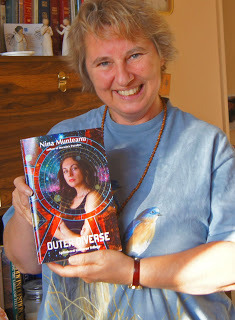 The universe is a very large place... But if you live in the Outer Diverse, like Galactic Guardian Rhea Hawke, it's even bigger... a lot bigger than she thinks, even... A lot bigger than I think...
The universe is a very large place... But if you live in the Outer Diverse, like Galactic Guardian Rhea Hawke, it's even bigger... a lot bigger than she thinks, even... A lot bigger than I think... I want to share my joy with you today...
I got my first look at Outer Diverse today when my publisher couriered me the proof. It arrived late this morning.
The door bell rang at 11 am and the courier handed me a package. I opened it and stared. The book was beautiful! I knew what it looked like; I'd been confering with the cover illustrator and designer, Costi Gurgu, for months. But I was still unprepared for the real thing. The raw power of the image and how it sat in my hands, soft and sleek and rich with colour.
For a writer, there's nothing quite like it -- seeing your book in its complete form for the first time, the tactile experience of seeing the fruits of your labor of love distilled into this wonderful package. It was a sensual delight that I embraced wholeheartedly. Like giving birth. It really is a lot like giving birth.
I should know. I've published five books. And given birth too. The similarities are, well, pretty similar... hehe... In every case, I felt an overwhelming sense of miraculous accomplishment with the help of very respected and competent individuals, not to say the least a divine hand. I still remember how, after laboring for many hours to deliver my son, I was overcome by such pure joy at seeing him revealed to me for the first time that I wanted 10 more just like him right then and there. As I looked upon the book cradled in my hands I felt the same kind of joy.
A writer writes because she has to. This lovely book in my hands was my reward.
Outer Diverse launches October 15th on Amazon, at Con*Cept and book stores near you. Outer Diverse will be carried by Bakka Phoenix Science Fiction Books in Toronto.
Published on September 29, 2011 23:37
September 18, 2011
Canadian Writers: Call for Submissions for Short Prose Contest
 If you're a Canadian writer and you haven't yet published, this contest offered by the Writer's Union of Canada might be for you! It offers a substantial prize of $2,500. Check it out, details below:
If you're a Canadian writer and you haven't yet published, this contest offered by the Writer's Union of Canada might be for you! It offers a substantial prize of $2,500. Check it out, details below:CALL FOR SUBMISSIONS for the 19th Annual Short Prose Competition for Developing Writers
$2,500 PRIZE
The Writers' Union of Canada is pleased to announce that submissions are being accepted until November 3, 2011 for the 19th Annual Short Prose Competition for Developing Writers. The winning entry will be the best Canadian work of up to 2,500 words in the English language, fiction or non-fiction, written by an unpublished author.
PRIZE $2,500 for the winning entry, and the entries of the winner and finalists will be submitted to three Canadian magazines.
JURY Writers Kevin Chong, Anne Emery, and Sylvia Fraser will serve as the jury.
ELIGIBILITY This competition is open to all Canadian citizens and landed immigrants who have not had a book published by a commercial or university press in any genre and who do not currently have a contract with a book publisher. Original and unpublished (English language) fiction or non-fiction is eligible.
HOW TO SUBMIT ENTRIES: · Entries should be typed, double-spaced, in a clear twelve-point font, and the pages numbered on 8.5 x 11 paper, not stapled. · Submissions will be accepted in hardcopy only. · Include a separate cover letter with title of story, full name, address, phone number, email address, word count, and number of pages of entry. · Please type the name of entrant and the title of entry on each numbered page. This is not a blind competition. · Make cheque or money order payable to The Writers' Union of Canada. Multiple entries can be submitted together and fees can be added and paid with one cheque or money order, $29 per entry. · Entries must be postmarked by November 3, 2011 to be eligible. ·
Mail entries to: SPC Competition, The Writers' Union of Canada, 90 Richmond Street East, Suite 200, Toronto, ON M5C 1P1. Results will be posted at www.writersunion.ca in February 2012. Manuscripts will not be returned.
There ya go. Good luck!
Published on September 18, 2011 12:28
August 5, 2011
Outer Diverse by Nina Munteanu
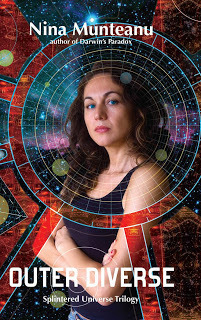 My latest book, Outer Diverse, is coming out this fall and we are launching it at Con*Cept in Montreal in October and Hal-Con in Halifax in November.
My latest book, Outer Diverse, is coming out this fall and we are launching it at Con*Cept in Montreal in October and Hal-Con in Halifax in November. I'm really excited about this book. It's the first of the Splintered Universe Trilogy . Here's a bit about it:
…Splintered Events, Single Destiny…
…An entire spiritual sect is inexplicably wiped out by Eclipse, the largest crime syndicate in the galaxy…
…Glitter Dust, a new seductive but dangerous contraband narcotic of mysterious origin and sold on the slipstream, is used by certain spiritual fanatics to travel to another dimension and "experience God"…
…An elite Eclipse assassin, known simply as the Rose, is entrusted with an eclectic hit list of prominent galactic citizens, including spiritual leaders, information pirates and dust traffickers…
…One of the Rose's targets, an eccentric priest, prophesies the Suntelia Aeon, a catastrophic End of Age, triggered by the joining of twin souls…
Galactic Guardian, Rhea Hawke, fears that this dire resurgence of an ancient prophesy may be fulfilled at last. She suspects that these latest moves by Eclipse are linked to the return of the cruel extra-galactic Vos. The Vos invaded thirty years ago and would have destroyed Earth if not for the intervention of a benevolent but arrogant alien race, the Eosians, who have now claimed Earth for themselves as their price.
This is going to be Rhea's hardest case yet—particularly since she's been taken off the case and fired by her Eosian boss for her most recent in a legacy of bungled missions. And Eclipse is gunning for her.
Rhea's desperate race to expose their plan before the galaxy falls again to the cruel Vos catapults her on a journey to the far reaches of the galaxy, where she will discover the shattering truth about duel twin worlds and her ultimate role in preserving or destroying them both.
Published on August 05, 2011 18:02
June 15, 2011
Celebrating the Bitch: Thelma & Louise
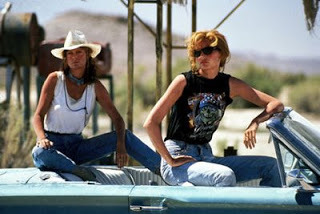 Twenty years ago Susan Sarandon and Geena Davis drove off a cliff into movie lore in Thelma & Louise. This "ground-breaking female buddy movie cum road-trip, crime spree and chase flick … deals with rape, a fatal shooting and sexual awakening, all to a country-rock soundtrack," says Linda Diebel of the Toronto Star in her recent tribute to this Ridley Scott motion picture and its Academy Award-winning screenwriter Callie Khouri. Thelma & Louise hit many firsts for women. It was one of the first movies to portray women using violence as an alternative form of action; it was the first to effectively show the raw power of women locked in friendship; and the first to depict a passionate choice for liberty in death vs. a compromised life.
Twenty years ago Susan Sarandon and Geena Davis drove off a cliff into movie lore in Thelma & Louise. This "ground-breaking female buddy movie cum road-trip, crime spree and chase flick … deals with rape, a fatal shooting and sexual awakening, all to a country-rock soundtrack," says Linda Diebel of the Toronto Star in her recent tribute to this Ridley Scott motion picture and its Academy Award-winning screenwriter Callie Khouri. Thelma & Louise hit many firsts for women. It was one of the first movies to portray women using violence as an alternative form of action; it was the first to effectively show the raw power of women locked in friendship; and the first to depict a passionate choice for liberty in death vs. a compromised life. From introducing Brad Pitt as a sex symbol to portraying women as independent and powerful, Thelma & Louise still resonates with a visceral message two decades after their iconic leap into the Grand Canyon. The ending, in which the pair lock hands and sail over the canyon in Louise's 1966 T-bird convertible, remains controversial even now. "People complained about our suicide," said Sarandon in an interview with Richard Ouzounian of the Toronto Star. "But I didn't hear a peep when Butch Cassidy and the Sundance Kid did pretty much the same thing."
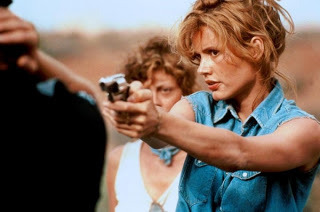 Author/activist Judy Rebick, president of the feminist National Action Committee in 1991, liked the movie for its portrayal of a powerful female friendship. "They fought back…they were free. They liberated themselves," she said in a telephone interview with Diebel. The movie showed Melanie Caplan, fragrance consultant in her 50s, that you can be powerful and not give in. "They controlled their destiny when women were [and still are generally] being portrayed as victims." In a world where they are expected to be rescued by men, I might add. Near the end of the movie, the sympathetic Arkansas police detective played by Harvey Keitel—their shining knight—does try and fails to "rescue" them.
Author/activist Judy Rebick, president of the feminist National Action Committee in 1991, liked the movie for its portrayal of a powerful female friendship. "They fought back…they were free. They liberated themselves," she said in a telephone interview with Diebel. The movie showed Melanie Caplan, fragrance consultant in her 50s, that you can be powerful and not give in. "They controlled their destiny when women were [and still are generally] being portrayed as victims." In a world where they are expected to be rescued by men, I might add. Near the end of the movie, the sympathetic Arkansas police detective played by Harvey Keitel—their shining knight—does try and fails to "rescue" them. That's what the controversial ending was about: not giving in. Not giving in to a false "god". Not giving in to the imposed rules and strictures of an androcratic* world. Not giving in to feelings of unworthiness and victimization. Not giving in to the oppression of the sacred feminine wisdom, the goddess in all of us. Celebrating The Bitch.
Thelma & Louise stirred a controversy of duality and sexism that still boils today. Several critics condemned Thelma & Louise "as a man-hating film because [Louise] shot and killed a rapist," said Sarandon. But, "how come they don't call men 'man-hating' when they shoot and kill each other in hundreds of films?" she challenged. It's like they're saying they can do it because they're MEN, but if women do it, then they're unnatural, bitches, and man-hating. "A woman today is still seen as a bitch if she's strong or in a powerful position." Caplan confided.
Ariane deBonvoisin of the Huffington Post suggested that many women live with the "fear of not being relevant ... of not making a difference ... of working on things that don't really matter in the important times of transition we live in. We're hungry to be part of making things better. We want to create, we want to do what we love again and find our voice. We sense intuitively that we have a critical role to play in shaping the future of our world. And yet, so many of us give in to excuses of not being good enough, young enough, wealthy enough, creative enough ... we still play small, still give in to the "victim" archetype.The conclusion of Thelma & Louise provided a potent metaphor of women's power to choose and the liberating nature of exercising that power. Some literalists saw the end as a simple act of desperation; it was, in fact, a powerful victory over the mundane roles women often feel forced to play and endure. "They were taking it for all women," Caplan said. "They stood for all women who had been made to feel not worthy and not as good as men…It was a rite of passage."
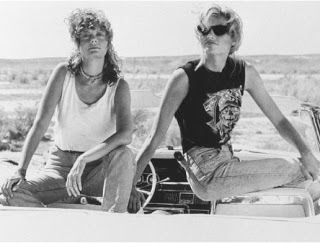 Media often promotes rivalries among women at the expense of solidarity. This is where Thelma & Louise triumph: a kiss, a look, two intertwined hands and two women riding off a cliff into history. It is one of the best examples of powerful friendship and solidarity. Solidarity against conformity. Solidarity against subservience. Solidarity against victimization.
Media often promotes rivalries among women at the expense of solidarity. This is where Thelma & Louise triumph: a kiss, a look, two intertwined hands and two women riding off a cliff into history. It is one of the best examples of powerful friendship and solidarity. Solidarity against conformity. Solidarity against subservience. Solidarity against victimization. The end was indeed mythic. "We all know what gravity is," a York university literature professor shared with Diebel of the T-bird's final seconds over the abyss. "But they're frozen there at the end, soaring" into the light.
"The film and that image electrified people around the world," says Ouzounian. But did it change anything? If it did, it wasn't obvious. "We're never able to build up any momentum," laments Davis. "Research shows that the percentage of female characters on screen has been the same since 1948. The percentage of female directors and writers is abysmal, still stuck in the single digits."
Momentum requires that three things co-exist: 1) vision; 2) drive, and 3) solidarity. If we are going to change the world for the better, we need to do it together. Here are the steps:
Step 1: Vision and self. Find your passion and follow Gandhi's maxim: "Be the change you seek in the world."
Step 2: Drive and staying power. Fuel the drive of your passion by sharing your vision with others of like-mind.
Step 3: Solidarity and community. Find and create a community of like-minded people and share it with the world. Think BIG.
* androcracy is defined by the Merriam Webster Dictionary as a system characterized by the political and social supremacy of men. In a previous piece entitled "Spiritual Ecology and the Lesson of Crete" I write: "[Riane] Eisler provides examples of sociobiologists who draw on nineteenth-century Darwinism by citing insect societies to support their androcratic (social and political rule by men) theories. If we are to truly rise victorious over the scourge of climate change—a function of our current lifestyle and paradigms—we will need to adopt a cultural evolution that embraces a partnership society heralded by new and renewed symbology, language and "myth".
Published on June 15, 2011 17:20



